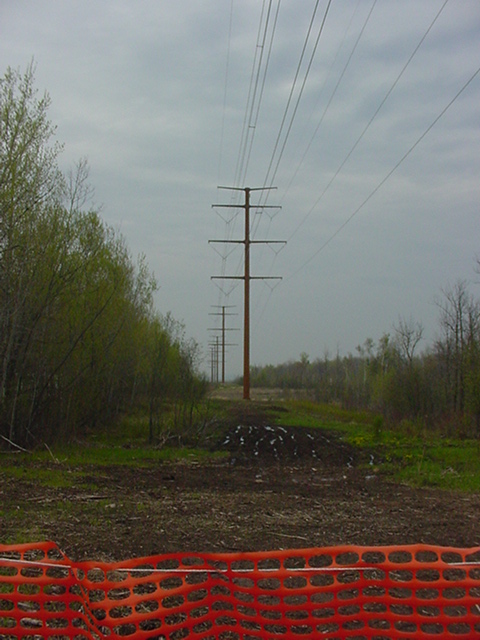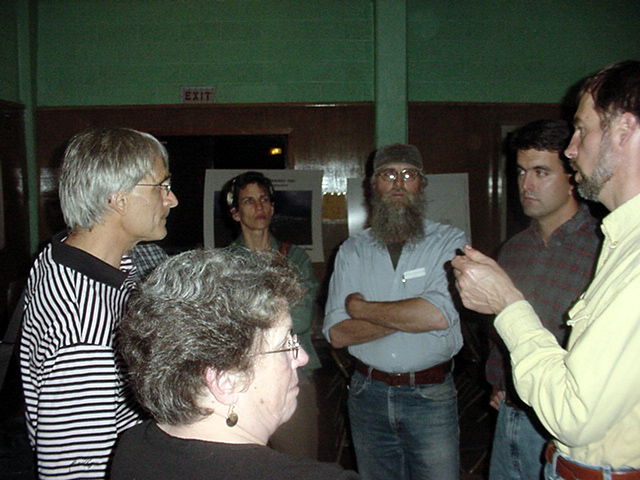Twins stadium — who wants to pay for it?
May 20th, 2006

This Twins stadium deal and the trio of stadium deals really sticks in my craw. I didn’t like it for the Humpdome, and now… don’t we learn? Decades ago, a whole bunch of artsy folks I knew, (“cafe society”, eh Ross?) shared the top floor of a warehouse across the street until it went upscale, and it was heaven with a view, except for Twins days, anyway, it’s been so long that I can’t even remember the particulars of that Metrodome deal that pissed me off so, but I remain pissed!!! Righteously pissed!!!! What do facts have to do with anything anyway… I mean, we’re talking about corporate welfare here! And this’ll be on my list of election issues!
In the STrib article today, Twins stadium critics stage protest, reveals the truth, the public doesn’t want to pay for this:
On Sunday, a Star Tribune Minnesota Poll showed that just 23 percent felt the Twins needed a new stadium the most over the Vikings and the University of Minnesota football team; two-thirds opposed public funding for a new stadium; and 78 percent felt that, should public money be spent on the stadium, a referendum should be required.
Yet it goes forward… WTF??? What about “two-thirds opposed public funding for a new stadium” don’ t they understand???
Twins stadium closer than ever
Dave Bicking, who ran for City Council last election, is fighting:
“We would at least like a chance to vote on this,” says Dave Bicking. He’s part of a citizen’s group fighting the sales tax that would pay for most of the new stadium. “Twenty-five years from now, I don’t think our highest priority will be paying our taxes for a new stadium.”
Bicking and those opposed to the tax want the issue put to voters while the Twins are happy a decade-long effort to get a new stadium could soon be over.
And in the STrib article today:
Auto mechanic Dave Bicking says opponents won’t forget at the ballot box in November and hopes to knock supporters out of office….
…But opponent Dave Bicking, who is organizing today’s protest at the governor’s residence, was more resigned.
“We’re exhausted,” he said. “Done deal? To be honest, it looks that way.”
I’m glad Bicking’s out there countering the lobbyists spin, reminding legislators that people do NOT want to pay for a stadium. It’s one more example of a private for-profit enterprise transferring the burden and risk to the public. Where that happens, we’d better be getting the profit, and when we don’t, legislators are NOT working in their constituents interest. Oh, I forgot, DUH, those who vote for the stadium regard the corporations as their primary constituents…
People??? Voters??? yeah… chopped liver… Time to VOTE NO AGAINST THEM ALL!
Taking the farm for transmission — it’s NOT for wind
May 19th, 2006

I’ve been finding snippets of the struggle out in SW Minnesota (PUC eDocket 01-1958) in my inbox that is painful to hear about from afar:
Do you know a Dave Callahan from Xcel ? Callahan is supposed to meet with a couple of us on the transmission line, neighbor diggng in heels as are several others, double circut pay is an issue, access is another…. on the easement compensation sheet, there is a 1099 item, the full paymet is listed here & reported to the feds., then further down the 50% reduction language was covered up by a sticker/arrow pointing to “sign below.” Another case of trickery.
It’s the same arrogant utility attitude that they encountered on the Minnesota side of the Arrowhead project, though the Arrowhead landowners inexplicably decided to pursue an ineffective action at the PUC rather than fight their case in court — they never argued their condemnation case, and even the judge was puzzled, so the opinion says.
Condemnation Part I Download file
Condemnation Part II Download file
And the “Buy the Farm” provision of the Power Plant Siting Act, 116C.63, Subd. 4 — when they lowered the threshold for High Voltagea Transmission Line to 100kV and above, the following year they went and raised the “Buy the Farm” threshold to 200kV and above — the majority of those affected by transmission lines now, because they’re building high capacity low-voltage lines, can’t opt out from living under the line.
And the particularly painful part of it is that party line, “It’s transmission for wind.” It’s NOT transmission for wind — here’s my “Transmission for Dummies #2” – scroll down to “It’s NOT for wind!” Here’s the powerflow that proves it, 213MVA out of the 2085 capacity coming down from Buffalo Ridge at the Nobles substation, the ONLY entry point from Buff Ridge on the line: View image
Here’s the story from the STrib:
Power play: Farmers fight Xcel
Southwestern Minnesota farmers challenge Xcel’s use of eminent domain and the compensation for use of their land.
Joy Powell, Star Tribune
The phone call came one morning during spring planting, when a man from a land-acquisition firm told Loren and Ethelyn Cuperus that part of their small farm near Lakefield, Minn., was condemned for construction of a new Xcel Energy power line.
For months, the couple had insisted that Xcel wasn’t offering an adequate payment to use the land — a 150-foot-wide strip through the middle of their farm in Jackson County. Xcel is moving ahead with the easement, the caller said, as part of a $162 million project to build transmission lines for the growing wind-energy industry.
“We’re not against wind energy,” said Loren Cuperus, 69. “We only want to be treated fairly. They want to bulldoze their way through.”
Depending on the site, Xcel has been offering 50 or 85 percent of the value of the land; farmers can continue to grow crops around the lines. But the Cuperuses and other farmers say that 50 percent is not a fair price for use of their land, for crops that will be reduced, and for damage to nutrient-rich brown loam during construction.
It’s a story that spotlights the controversy over eminent domain, with which governments or utilities can buy property from unwilling sellers for an important public use.
Xcel, which has revenue of $10 billion a year, says its project is essential to operate the above-ground transmission line and provide more electricity, primarily from wind. The new lines will more than double transmission capacity from southwestern Minnesota and boost its burgeoning wind industry, said Paul Adelmann, an Xcel spokesman.
In 2003, the Minnesota Public Utilities Commission (PUC) approved Xcel’s highest-voltage power line, which will stretch 94 miles from Brandon, S.D., near Sioux Falls, to Lakefield. It also involves three smaller lines and other improvements to strengthen the entire electricity network, from the blustery Buffalo Ridge area in southwestern Minnesota to the Twin Cities and throughout the region, Adelmann said.
So far, Xcel has reached agreements with owners of 102 of the 395 parcels involved. Another 68 parcels are being negotiated. Owners of 225 parcels have yet to receive offers.
An issue for owners of 80 parcels, including the Cuperuses, is whether they’ll receive less because they already have older power lines that would be replaced or upgraded.
To deal with farmers, Xcel hired an Iowa firm, Graham Land Acquisition Associates. It specializes in helping public works, utilities and economic development projects acquire land through condemnation.
Loren and Ethelyn Cuperus and other farmers say they’ve been “threatened” with condemnation during encounters with the firm’s representatives.
Dave Callahan, who leads the siting and land rights department for Xcel Energy, said he has heard the complaints and is trying to work out solutions.
“When we ask the landowners for specifics, what we find out is that the agent just told them the truth and they didn’t like what they heard,” Callahan said. “This is an essential service project that was approved by the PUC.”
Figuring fair compensation
On a Sunday last January, the Cuperuses, their widowed neighbor, Beverly Voehl, and a farmer who rents land on the 400-acre Cuperus farm met with a Graham representative, Brian Jennings.
The farmers said Jennings told them that if they wrote down what he was saying, he would not tell them any more.
Attempts to reach Jennings for comment this week were rebuffed by a Graham Land Acquisition official, Carroll McCracken. “We are under contract [with Xcel] to not talk with you for this project … so you have to contact Xcel Energy,” McCracken said.
Voehl ended up signing papers for an Xcel easement, although she felt bullied and disrespected, she said. The Cuperuses refused to sign because they would have been paid at a lower rate for some of their land.
That’s because in 1966, Loren’s father received a one-time payment for easements. Interstate Power and Light Co. paid his father $445 for a strip of land 75 feet wide and a half-mile long, Cuperus said. The right-of-way encompassed five “H-frame” poles, for which his father received $65 per pole, plus $120 for a wire overhang.
Now, new single poles are to replace the older double poles on the farm as part of Xcel’s 345-kilovolt line from South Dakota to a Lakefield substation in Jackson County.
Where no power poles exist, Xcel has paid farmers $3,060 per acre, which represents 85 percent of the current value of the land. The farmers still can farm on it.
Where poles already exist and will be replaced or updated, farmers have been offered 50 percent of the value, or $1,530 an acre, for the perpetual easement. Farmers still are negotiating with Xcel on that amount.
Cuperus and other farmers also say they should be receiving more for crop damage and dirt compaction and be assured timely repair of drainage tile that gets broken during construction.
“I probably have never negotiated with a landowner who didn’t think they should get more,” Callahan said. “That’s why we rely on established appraisal practices.”
Callahan said Xcel added a “signing bonus” of $1,000 for those who agreed to an easement.
‘Green’ energy is in demand
This spring, Xcel became the nation’s biggest buyer of wind energy, according to the American Wind Energy Association.
Utilities in the region expect to need 6,000 megawatts of new electricity generation to meet needs in the next 15 years, with the Twin Cities the biggest draw on that power, according to the state Commerce Department.
The department is calling on Xcel Energy to boost investments in wind energy and use less natural gas. Xcel faces a tight construction schedule as it replaces old H-style powerlines with single poles for the higher-voltage lines, Callahan said.
The utility is launching “quick-take” processes to acquire land through condemnation, according to documents sent to Loren and Ethelyn Cuperus. A court date is set for May 31, but negotiations continue.
The couple’s friend, Dave Ackermann of Lakefield, is another farmland owner fighting for higher compensation for the Xcel easements. Down the road, he said, it’s not just rural people who could be affected.
“How would people in the city like to have a 345-kilovolt line going their yard,” Ackermann asked, “and their kids playing under it?”
Joy Powell â?¢ 612-673-7750
Did you catch this LIE:
Xcel, which has revenue of $10 billion a year, says its project is essential to operate the above-ground transmission line and provide more electricity, primarily from wind. The new lines will more than double transmission capacity from southwestern Minnesota and boost its burgeoning wind industry, said Paul Adelmann, an Xcel spokesman.
Ya know, I’m a math idiot, but I know that 213 out of 2085 is NOT “PRIMARILY!”
And did you catch this half truth:
The new lines will more than double transmission capacity from southwestern Minnesota..
.
Change the “from” to “through” and you’ve got it — a line running from Sioux Falls (Split Rock sub) to Lakefield Junction isn’t going “from” SW MN, it’s going THROUGH it.
The farmers out there know who pays and who benefits, and it’s too bad that deals were made that allow Xcel to say “it’s for wind” when it’s not, when only 213MVA of the 2085MVA capacity is coming off of Buffalo Ridge. Xcel’s engineer, Rick Gonzalez, went over the powerflows in testimony in the SW MN case, it’s there in the record for anyone who cares to look…
CUB says Arrowhead transmission design is flawed
May 18th, 2006

Citizens Utility Board has filed with WI’s Public Service Commission, saying the design of the Arrowhead-Weston Transmission Line is flawed. Yeah… your point???
From today’s St.PPP:
Group alleges flaws in powerline
But transmission company says complaint is old, has no meritAssociated Press
MADISON â?? A utility watchdog group asked state regulators Tuesday to investigate what it says are serious flaws in the design of a high-voltage transmission line under construction between Wausau and Duluth, Minn.
In a worst-case scenario, a failure with the line could lead to a cascade of outages and possible damage to power plants, said Charlie Higley, executive director of the Citizens Utility Board.
But Mark Williamson, vice president of Pewaukee-based American Transmission Co., said the group’s concerns are unfounded and based on a “flawed” analysis that already has been investigated.
American Transmission will own and operate the $420 million line, being built by Wisconsin Public Service Corp., when it is brought into service in 2008.
In a letter delivered to each company, the citizens’ group said engineering mistakes mean the 345-kilovolt Arrowhead-Weston power line is undersized in capacity.
“The Arrowhead line will likely not work when it’s most needed,” Higley said. “And that’s when it’s helping support other transmission lines in the region while power is flowing heavily. That’s when the line is most vulnerable.”
Linda Barth, a spokeswoman for the state Public Service Commission, said the regulatory agency is looking at the issues raised in the group’s letter.
“But that said, this line has been approved twice and we’re confident in the exhaustive process we used in approving the Arrowhead-Weston line,” she said. “It was a sound and thorough decision.”
The Citizens Utility Board raised its concerns following an in-depth analysis by Larry Thiele, an independent consulting electrical engineer. The board hired Thiele in 2003 to provide expert testimony regarding the line’s design.
Thiele’s analysis concluded the line would fail if an outage occurred on the King-Eau Claire-Arpin transmission line, the only high-capacity line connecting Wisconsin directly to Minnesota. The failure would cause transmission lines to carry too much power and could damage power plants and lead to blackouts, Thiele concluded.
Williamson said those concerns had already been investigated and dismissed.
“This is the third time that the same complaint has been raised and there’s just no merit to it,” he said.
He said the purpose of the Arrowhead line was to strengthen the system by providing redundancy and protection for the power grid â?? solving the very problems Thiele says would threaten it.
Here’s the CUB Request for Investigation: Download file
Essentially, they’re saying that the Arrowhead line is unstable because the capacity is too low. But it seems to me they’re not taking into account the old news of the EQB’s design requirement of a capacity limitation of 800MVA through the phase shifting transformer. Here’s the MPCA Commissioner’s Memorandum to the EQB that resulted in the limitation: Download file
Mesaba Interconnection
Through all of this though, no one’s paying any attention to the impact of Mesaba on Arrowhead. Originally they were planning on connecting to Blackberry and from there going to the Forbes sub and out over Arrowhead — thankfully that is not now in the plans (it seems). Now it’s going from Blackberry to the Riverton sub. The MISO interconnection study, G519, has just been released:
MISO System Interconnection Study G519
The Conclusion of the study states that:
Under high off peak transfer conditions G519 aggravates voltage problems at 230kV, 161kV and 115kV buses around Arrowhead and Stone Lake. (Ch. 7, p. 7-1)
Going to the horse’s mouth, it says:
Transient voltage violations are attributed to the G51 project. HOwever, Table 5-2 shows that in the G519 study model the Forbes-Chisago 500kV line (F601C) is overloaded and Arrowhead-Weston is loaded above its expected operating limit of 650MW. Sensitivity analysis, presented in Section 6, was performed to verify the potential constraints with flows on F601C and Arrowhead-Weston within limits. (Ch. 5, p. 5-7)
The MISO study found that the connection of Mesaba adds to stability problems, and the modeling assumes the line is operating at above the stated capacity, above the limits, but below the phase shifting transformer limits.
More on what it means for Mesaba, but the bottom line is that Excelsior will have to have “someone” (because heaving forbid they would be responsible for their own infrastructure) make the following associated transmission system upgrades:
1) Add new 230kV line from Boswell to Riverton
2) New 230kV bus position for Boswell-Riverton line at Boswell
3) New 230kV bus position for Boswell-riverton line at Riverton
4) New 230kV subsation at Hill City
5) Replace 4 115kV circuit breakers at Nashwauk
Corresponding costs:
1) $45 million
2) $1.9 million
3) $1.7 million
4) $3.5 million
5) $720,000
TOTAL NECESSARY MESABA UPGRADES: $52.82 million
And remember, this does not include the direct interconnection costs from the plant to the Blackberry sub… and I think those costs are grossly underestimated.
Lots more on this topic later!
On Wisconsin: Now Republicans go down in flames
May 18th, 2006

It’s been bipartisanship through and through, and now it’s the R’s turn. Go to Scott Jensen’s district’s legislative page and what do you find? VACANT
In today’s StPPP: Jensen gets 15 months in prison
Prosecutors spent two weeks during his trial putting a string of his Capitol aides and former legislative workers on the stand.
They testified they served as field campaign operatives, held campaign strategy meetings in both Jensen’s office and other state offices, recruited candidates and produced campaign literature on their state computers, all under Jensen’s oversight. They also testified Jensen used legislative aide Sherry Schultz as a full-time campaign fundraiser who would guide Republican candidates.
And more description of their illegal behavior from a JSOnline article: Jensen guilty of 3 felonies
Their testimony painted a stunning picture of a GOP election and re-election machine paid for by taxpayers:
With Jensen running it before the 1998 and 2000 elections, the Assembly Republican Caucus recruited candidates; plotted ways to get incumbent Democrats to not seek re-election; organized fund-raising events; and used state-paid graphic artists to do invitations and thank-you notes for them.
Those workers also solicited lobbyists to give to “vulnerable” GOP candidates; devised strategy plans based on poll results; assigned state-paid aides to specific races; and coordinated the filming of TV ads, using state-paid workers as extras.
Throughout, Jensen whined about “selective prosecution” claiming “the Democrats were doing it too” but the Democrats were jailed too — he’s clearly not getting it, is he…
Taconite hosts meeting on Mesaba Project
May 17th, 2006

Pat Micheletti hiding behind a local landowner!
He was trying hard not to get caught, but I was persistent, missed a great shot with his hand in front of the lens, couldn’t get the camera on in time! He asked me why I don’t like the project, and I don’t think wanted a point by point description — and it made me think that I really should have that in talking points, so that’s something to do on the drive home.
But on a serious note, this was by far the best meeting on Mesaba yet, because this time there was more give and take, and no Tom Micheletti to screw up the public relations! Michael Wadley presented, and gave a very detailed overview, and he’s obviously been doing his homework and has learned a lot about coal gasification — but hey, it’s not nuclear science, eh? He was pushed by many of the audience members, some challenged the job estimates and wanted to know what the qualifications would be, how many locals could really get a job there. There were good questions about the meaning of “jobs” in the “Duluth” report, and the discrepancy between that report and the numbers in the PUC application, and Mike did well explaining the way it was calculated and how that was modified for the PUC — the Duluth report calls one job for one person for one hour “a job” and the PUC was more in line with reality that it takes more than that to make a “job” (my summary). Wadley gave his own example, starting pushing a broom at Prairie Island, and he should have given Steve Murphy’s example, parlaying his NSP job into the Senate as a “company” senator — Dog knows they need some new representation up here! (Saxhaug’s got to go! Rumor has it he’s not running again, if only Solberg would say the same, both have abandoned their constituents in favor of Excelsior/Mesaba). Others had questions about the plume of pollutants, and there was a wind rose posted which suprisingly showed most wind… as I think about this I might have it exactly backwards, more on this later.
One thing I’d recommend is to have someone who has authorization to address the economic issues — there’s this presumption that “regular folks” are interested only in the environmental issues, and that’s not true! Locals are very concerned about the costs to their community — what it means for the County to be considering a rail spur, essentially becoming a short line railroad (really… more on that later), or for Taconite to be expanding its water treatment plant (Taconite, Bovey, Coleraine joint plant), and what all these perks that Excelsior is getting mean to them, and the impact on the cost to ratepayers and taxpayers. People do care about this stuff and they get it, they know pork when they see it, they know corporate welfare when they see it, and when they’re working so hard to get by, watching their taxes to up and up and up, people don’t like to see exceptions for risky corporate for-profit businesses. Excelsior’s financing transfers the burden of a risky private enterprise to the public, and someone had better figure out how to answer the public’s questions!
Info and questions that stood out last night:
* They expect to achieve an efficiency of “greater than 50%!” This i gotta see, because typically coal gasification is doing good ti get a 40-41% efficiency rate.
* Sulphur — recovery is around 99%, but even with that, 1.5 tons a day goes out the stack
* Mercury — disposal of mercury laden carbon (or recycling of carbon) depends on how quickly it loads up, and that’s not known
* Coal supply requires 5 trains in and out weekly, 115 cars each, no switching yard, but there is unloading
^ ZLD – Zero liquid discharge — it means there’s no discharge on site, but it is recycled through plant and after some treatment, goes into cooling towers and then out. They are planning to incorporate into waters where there is already known mercury discuarge (I need more info on this, it’s hard to figure out what the water situation is because it keeps changing)
* Transmission studies are done and on the MISO site (I’ll dig for this when I get home)
* Financing will be nailed down first quarter 2007
* Stacks are 150 feet high, compared with 500-700ft stacks at Boswell — “not higher because we don’t need it” because they don’t pollute like a coal plant
* Most of the financial questions remained unanswered, so I’ll be putting together a list of what I’m hearing people comment on, and will forward that to Excelsior.
Excelsior Energy’s site: www.excelsiorenergy.com
I can’t find the PUC filings there…
To find the PUC application, which has a detailed project description, go to www.mncoalgasplant.com
Here’s the Annandale decision, the one that does not allow discharge into impaired water:
There’s a poll in the Grand Rapids Herald Review, and as Al Franken says, vote early and vote often. Last I saw there were 336 votes, and 64% opposed!

Local residents talking with “Jim,” who is probably Jim Milkovich, of Excelsior.